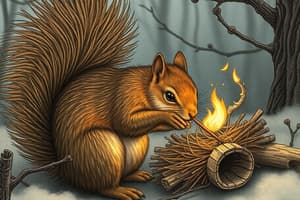Podcast
Questions and Answers
What is the purpose of the blocked-rotor test?
What is the purpose of the blocked-rotor test?
- To evaluate the motor's performance at rated current (correct)
- To analyze the relationship between voltage and resistance
- To measure the efficiency of the generator
- To determine the input current under no load conditions
In the circle diagram construction, what does the angle $d$ represent?
In the circle diagram construction, what does the angle $d$ represent?
- The angle using the rated phase voltage and blocked rotor current
- The angle between the load current and the stator copper loss
- The angle between the current scale and the Y-axis (correct)
- The angle between the output line and the torque line
What is meant by 'synchronous watts' in the context of the circle diagram?
What is meant by 'synchronous watts' in the context of the circle diagram?
- The power supplied to the motor during idle operation
- The power used to overcome internal resistance in the circuit
- The component of power factoring in speed and torque (correct)
- The maximum power the motor can generate without slip
How is the rotor copper loss related to the stator copper loss in the blocked-rotor test?
How is the rotor copper loss related to the stator copper loss in the blocked-rotor test?
What does point P represent in the context of the torque line in the circle diagram?
What does point P represent in the context of the torque line in the circle diagram?
To find the maximum torque and slip corresponding to maximum torque, which method is used?
To find the maximum torque and slip corresponding to maximum torque, which method is used?
What total input parameters can be extrapolated from point P2 when working as a generator?
What total input parameters can be extrapolated from point P2 when working as a generator?
What type of current scale is suitable for the blocked-rotor test?
What type of current scale is suitable for the blocked-rotor test?
What is the purpose of the no-load and blocked rotor tests on a 3-phase squirrel cage induction motor?
What is the purpose of the no-load and blocked rotor tests on a 3-phase squirrel cage induction motor?
In the context of the circle diagram for a 3-phase induction motor, what does the diameter of the semi-circle represent?
In the context of the circle diagram for a 3-phase induction motor, what does the diameter of the semi-circle represent?
What happens to the current locus of a 3-phase induction motor as resistance increases from 0 to 1?
What happens to the current locus of a 3-phase induction motor as resistance increases from 0 to 1?
What parameters can be obtained from the circle diagram for a squirrel cage induction motor?
What parameters can be obtained from the circle diagram for a squirrel cage induction motor?
What does slip refer to in the context of an induction motor's operation?
What does slip refer to in the context of an induction motor's operation?
During the no-load test, what is the primary objective once the steady state is reached?
During the no-load test, what is the primary objective once the steady state is reached?
What accessory is used to gradually apply the rated voltage during the no-load test of a squirrel cage motor?
What accessory is used to gradually apply the rated voltage during the no-load test of a squirrel cage motor?
What characteristic is plotted against output to obtain the torque-slip characteristics?
What characteristic is plotted against output to obtain the torque-slip characteristics?
Flashcards are hidden until you start studying
Study Notes
Objectives of the Tests
- Draw the circle diagram and obtain torque-slip characteristics for slip ranging from 0 to 1.
- Plot current, torque, power factor, efficiency, and slip against output characteristics for both stable and unstable regions.
- Determine the line current, power factor, and slip at full load output using the circle diagram.
- Predetermine maximum torque and corresponding slip from the circle diagram.
- Obtain the rotational speed when the motor operates as a generator using the circle diagram.
Equipment Required
- Motor: 3-phase squirrel cage induction motor, 5HP, 7.3A, 1440 RPM, 50 Hz, 400/440 V.
- Ammeter: MI 0-5A, 0-10A; MC 0-5A.
- Voltmeter: MI 0-600V, 0-150V; MC 0-15V.
- Wattmeter: 150V, 10A (upf); 500V, 5A (ipf).
- Other: 1002, 5A rheostat.
Principle of Testing
- No-load and blocked rotor tests provide data to calculate induction motor equivalent circuit parameters.
- Equivalent circuit behaves like a series R-L circuit with constant reactance and variable resistance.
- Current locus resembles a semi-circle, with the diameter indicating maximum current.
Procedure
- No-Load Test:
- Connect motor through an auto transformer starter.
- Gradually apply rated voltage to minimize starting current.
- Obtain steady-state no-load readings noted in a table.
- Blocked-Rotor Test:
- Connect the motor via an auto transformer and physically block the rotor.
- Gradually increase voltage until rated current is reached.
- Record meter readings and measure winding resistance.
Data Processing
- Draw the circle diagram using required data: ( I_o, I_{sc}, I_{2}' ) and se.
- ( I_{2}' ) (blocked rotor current at rated voltage) is calculated with ( I_{se} \times \text{Rated phase voltage} ).
- Choose a suitable current scale (e.g., 1 cm = 1 ampere).
- Power scale defined as ( 1 \text{ cm} = 3 \times V_{ph} \times \text{Current scale} ).
Circle Diagram Construction
- Plot the current vector ( OA ) at angle ( d ) to Y-axis with length equivalent to current scale.
- Draw vector ( OB ) at angle ( se ) such that length matches ( I_{2} ) to scale; join points A and B.
- Construct a perpendicular bisector to line AB, meeting the horizontal line through A at point D; draw a semi-circle with radius DA.
- Drop a vertical from B to line AD to establish point E, and select point F on BE for rotor and stator copper loss ratio.
- Define output line AB and torque line AF; plot points ( L_{i} ) on the semi-circle and calculate respective values for torque, power loss, efficiency, and slip.
- Analyze maximum torque by drawing a tangent to the torque line that contacts the circle; this gives maximum torque and corresponding slip.
Results
- Successfully draw the circle diagram and plot performance characteristics based on the data obtained, providing detailed insights into the motor's behavior under different loads.
Studying That Suits You
Use AI to generate personalized quizzes and flashcards to suit your learning preferences.




